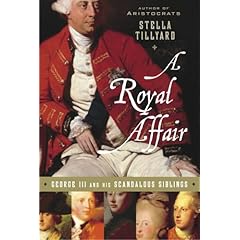 I had no idea that at the same time, or just before, George III was dealing with his rebellious American “children,” he was also in the throes of despair over his siblings’ rebellion and scandalous behavior. As the eldest brother and the king, George III felt responsible for his younger siblings’ behavior just as he considered himself a father figure for the American colonists. He was ultimately disappointed in all of his surrogate children as well as some of his own fifteen children, including the Prince of Wales, later George IV.
I had no idea that at the same time, or just before, George III was dealing with his rebellious American “children,” he was also in the throes of despair over his siblings’ rebellion and scandalous behavior. As the eldest brother and the king, George III felt responsible for his younger siblings’ behavior just as he considered himself a father figure for the American colonists. He was ultimately disappointed in all of his surrogate children as well as some of his own fifteen children, including the Prince of Wales, later George IV.
The next younger brother in George III’s family, his brother Edward, was a rake and a womanizer, but since he died young, he was unable to do too much damage to the royal family’s reputation. The other siblings made up for his short life and lack of opportunity.
George’s eldest sister, Augusta, married the Prince of Brunswick who proceeded to ignore her and patronize his mistresses instead. She became, understandably, bitter and made her brother George miserable with all her complaining letters.
George’s younger sister Caroline Mathilde, also given away in a diplomatic marriage to the crown prince of Denmark, found her husband to be uninterested, uninteresting, and quite insane. She didn’t just complain; she had an affair with her husband’s doctor and took over the country with her lover’s help and in her husband’s name. King Frederick was content to just sign on the dotted line anything his loving wife and her paramour prepared, and for a while the three of them had a satisfying menage a trois. Eventually, Caroline’s political enemies took charge of the mad king and broke up the party. George had to clean up his sister’s mess by rescuing her from a court that had turned against her. Soap opera material.
Two of George’s brothers contracted secret marriages to less-than-desirable women without their kingly brother’s permission. This disregard for his royal prerogatives made George III quite miffed, and he refused to speak to the wives or receive them at court . . . ever. Even worse, prior to his marriage one of the brothers, Henry, the Duke of Cumberland, had a very public affair with a married woman, was sued by the husband, and ended up owing quite a settlement to the husband of his mistress.
If you’re interested in court gossip and intrigue that’s only a couple of hundred years old, George’s scandalous siblings should quench your appetite. George is the only one of the royals in the book who comes out with a decent reputation and an intact marriage. And he’s the one the writers of the Declaration of Independence called “A Prince, whose character is thus marked by every act which may define a Tyrant, . . . unfit to be the ruler of a free People.”
Oh, well, maybe they didn’t know much about the “character” of the rest of the royal family.
(By the way, the big guy on the cover is George himself, but I don’t know why the cover designer cut off part of his head. Do you like the way book cover artists and designers tend to do that these days, crop off body parts including heads? Is it a statement or a symbol of some kind? I think it’s sort of weird.)
Other bloggers’ reviews:
John Sandoe: “Stella Tillyard tells this astonishing tale with bravura and energy. But there is a problem with the book, which is that the story of Caroline Mathilde and Struense utterly overshadows the others.”
History Maven: “Interesting read for those interested in the period. Well written, and makes me realize I don’t know my Danish history. Goody! New topic!”